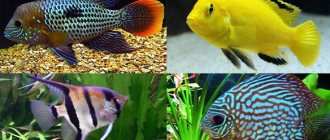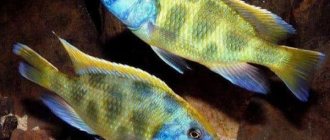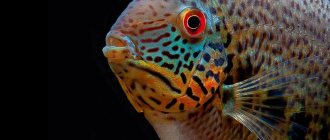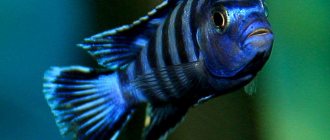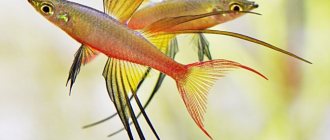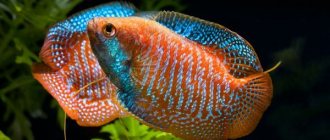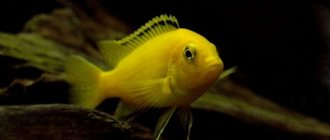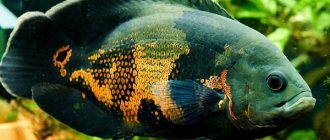Melanochromis auratus (lat. Melanochromis auratus) or golden parrot is one of the pugnacious cichlids of Lake Malawi. What is typical for auratus is that the female and the male have opposite colors, the males have a dark body with yellow and blue stripes, and the females are yellow with dark stripes. This coloring makes life easier for aquarists, since it is clearly visible where everyone is and fights between males can be avoided.
Description
Small freshwater fish grow up to 11 cm in length. The female and male auratus have different colors and look like representatives of different species.
Appearance
Melanochromis have an elongated body, large eyes and a small mouth. The mouth has incisors for cutting algae. The dorsal fin is long and translucent. Males of Melanochromis auratus are dark in color. The horizontal stripe running across the entire body is yellow. The golden caudal fin has dark spots. Females are yellow with a black stripe, the tail is light with dark spots. The dorsal fin is yellow with dark spots. In an aquarium with only females, the dominant individual develops male characteristics.
Behavior
It is difficult to select neighbors due to their aggressive and territorial nature. Males are especially warlike towards each other, females are more tolerant. Auratus live in a harem of 1 male and 6–8 females. Without a territory, they live alone or gather in flocks of 8–10 individuals.
Lifespan
Melanochromis golden lives on average 5 years.
Reviews
The newly acquired golden melanochromis quickly adapts to the aquarium. Aquarists love to watch this cichlid. The fish has an interesting appearance and habits.
Feeding
The diet of auratus consists mainly of plant foods:
- spirulina;
- lettuce leaves and dandelions;
- spinach;
- duckweed;
- peas
The additions are:
- coretra;
- daphnia;
- dry food;
- bloodworm.
Be careful when feeding bloodworms. The abundance of protein foods causes melanochromis to become ill. Do not include beef heart in the auratus diet. Feed melanochromis 3-4 times a day in small portions, removing uneaten leftovers immediately.
Tank preparation
When choosing water, you should give preference to a hard alkaline liquid, without saltiness. In some cases, salt acts as a hardening agent. In addition, melanochromis take root well in slightly salty water, so its presence is occasionally allowed. However, the fish will not survive in a completely salted aquarium, since the maximum permissible salinity percentage reaches 10 percent.
The volume of the aquarium for these creatures should be at least 190 liters. And if the owner of the fish plans to breed them or place other creatures in the tank, then the optimal volume will be 450 liters. Only fresh water is used, except in certain circumstances when salt must be used.
When arranging a home for auratus, it is important to take care of a filtration system that will ensure proper water movement. The role of soil is played by small corals, raising the acidity level to the required levels
You can also purchase special soil for freshwater fish in the store.
Due to their resistant nature to a changed environment, the fish will get used to a certain pH level, but in order for their growth and development to be as productive as possible, it is better to provide comfortable conditions before placing the creatures in the aquarium.
When arranging a home for auratus, it is important to take care of a filtration system that will ensure proper water movement. A pH value that is too high indicates a large accumulation of ammonia in the water.
If appropriate measures are not taken, this can cause fatal consequences, including the death of the entire auratus family. To avoid such developments, it is enough to change the water in the aquarium on time
A pH that is too high indicates a large accumulation of ammonia in the water. If appropriate measures are not taken, this can cause fatal consequences, including the death of the entire auratus family. To avoid such developments, it is enough to change the water in the aquarium on time.
Experts also recommend placing all kinds of stone decorations in the aquarium to create tunnels and caves. It is better to refuse a large number of plants, as they will be mercilessly destroyed by golden parrots. Fish grow and develop especially well in spacious tanks, where there is room for free swimming.
Compatibility
Golden cichlids are aggressive, so it is optimal to keep auratus in a species aquarium with one male or alone.
It is permissible to stock Melanoroms Auratos with other Mbuna cichlids with a similar disposition:
- labeotropheus;
- blue dolphin;
- hummingbird cichlid;
- zebra mbuna;
- Lombardo.
Choose a large tank for auratus and other species. If there are shelters, then the likelihood that golden parrots will attack their neighbors decreases. If you want to keep several groups of different species, remember that each male accounts for at least 200 liters. And also fast fish that live in the upper layers of water, for example, rainbowfish and Sumatran barbs, are placed with the melanochromis aurathus.
View this post on Instagram
Llegada de cíclidos africanos #cichild #fish #peces #aquarium #pseudotropheus #melanochromis #cichildsafricans #acuarios #aquariums
A post shared by acuatec.com (@acuatec_acuarioszaragoza) on Aug 16, 2021 at 4:52am PDT
Keeping in an aquarium
The water in Lake Malawi is very hard and contains a large amount of minerals. In addition, the lake is very large and the average daily fluctuations in pH and temperature are minimal. So stability is an important part of keeping mbuna cichilid fish.
Water for keeping auratus should be hard (6 - 10 dGH) with a pH of 7.7-8.6 and a temperature of 23-28°C. If you live in a region with much softer water, then the hardness will have to be increased, for example, using coral chips added to the soil.
In nature, Mbuna live in areas with a lot of stones at the bottom and sand as soil. In the aquarium, you need to recreate the same conditions - a large number of shelters, sand, hard and alkaline water.
At the same time, they actively dig in the ground, and stones can be undermined. Plants do not need to be planted at all; melanochromis need them only as food.
Note that all African cichlids need water with stable parameters, clean and with a high content of dissolved oxygen. Therefore, using a powerful external filter is not a luxury, but an absolutely necessary condition.
Breeding
Melanochromis spawning is easily stimulated by increasing temperature. Reproduction occurs in a general aquarium and spawning tank. Golden cichlids are caring parents who carefully protect their offspring. The fish should have enough free space and shelter.
Differences between a male and a female
Color appears at 6–9 months. During the spawning period, the male's color becomes twice as bright and his temperament becomes more aggressive. The colors of fish of different sexes vary: the body color of males is dark, females are golden.
Spawning
During the breeding season, the male shows interest in the female. The female, ready for spawning, swims into the territory of the male. The clutch consists of 40–100 eggs, which the auratus incubates in its mouth for three weeks. Parents look after the fry after hatching; until the age of 3 months, the fry hide in their mouths from danger. Feed the fry Artemia nauplii, crushed food with herbal supplements. Pay special attention to the purity of water.
Introduction
Cichlids are an unusually wide group of freshwater fish found on virtually every continent on the planet. Currently, almost two thousand species have been described, and many scientists agree that this is far from the limit. Among the Cichlid family you can find a wide variety of fish, differing in size, body shape, color and type of diet. It is not surprising that many of them have become well-deserved aquarium favorites.
It is worth noting that cichlids are not only beautiful, but also extremely smart fish. Many of them exhibit amazing forms of interaction with each other, protecting the territory and raising offspring. Some species are able to recognize their owner, take food from their hands, and even allow themselves to be stroked.
We bring to your attention the top 10 most popular cichlids kept by aquarists around the world.
Diseases
In poor-quality water due to constant stress, melanochromis is susceptible to diseases:
- Bloating Malawi. The fish becomes lethargic, loses appetite, and the abdomen swells. The disease is accompanied by bulging eyes and rapid breathing of the fish. The disease lasts 3 days, leading to the death of the animal. Treat your fish with antibiotics.
- Ichthyophthiriasis (semolina). White dots appear on the body of Auratus caused by parasites. An infected individual itches on the decorations and behaves restlessly. Can be successfully treated with medications from a pet store.
- Iridovirus. It is introduced into an aquarium with sick fish and is transmitted between representatives of the same species. Difficult to treat.
- Chlorine and ammonia poisoning. Unsettled tap water may contain too much chlorine, which is harmful to fish. In an aquarium that has not been serviced for a long time, ammonia causes poisoning. Increase aeration and change water more often. Water conditioners often help.
- Tuberculosis. A fatal disease that appears in an aquarium with infected fish. Tuberculosis in cichlids is accompanied by body deformation, loss of appetite, pale color and clouding of the eyes. Treatment with kanamycin is carried out in the early stages. For 10 g of food add 10 mg of the drug.
Golden Malawian cichlid
A very aggressive cichlid from Lake Malawi (Africa): not only males, but also females demonstrate pugnacious behavior in this species. Melanochromis golden (lat. Melanochromis auratus) is sometimes called the golden parrot, it is also called the golden mbuna or Malawi golden cichlid.
Reproduction and appearance
This type of melanochromis is most often bred in home and species aquariums in public places. The reason is the rich, bright color and unpretentiousness. Sometimes you can come across statements that these cichlids are relatively peaceful, which is also a plus in their favor. They can even breed in a community aquarium, as the fry develop in the female's mouth (unlike the arowana, in which the fry is carried in the male's mouth). After three weeks, the babies are ready to live and feed on their own, hiding in the thickets of plants and among the decorations of the aquarium.
From the editor: About dry food for ancistrus
Melanochromis auratus has an appearance characteristic of many cichlids:
- slender elongated body slightly compressed from the sides;
- a large head with a terminal mouth with thick lips;
- elongated dorsal fin
The length of males can be up to 11 centimeters, females are slightly smaller - up to 9-10 centimeters.
Color of males and females
Adult males and females differ very well in color. Juvenile golden melanochromis are yellow with two black stripes along each side and a third on the dorsal fin. The lower stripe starts from the eye and extends to the middle of the caudal fin.
By the time of puberty (6-9 months), the color of males changes: the yellowness goes away, and they become darker. The final adult color of males is formed by the age of one year:
- the abdomen and body become dark;
- on each side there are two light yellowish-blue stripes running from the eye to the beginning of the caudal fin.
Mature females completely retain the yellow color and black stripes, as they had at a young age. In females, the upper part of the caudal fin is decorated with a black spotted pattern on a white background, and its lower part is yellow. Probably, the name of the cichlid Melanochromis golden is associated with the color of the females. Therefore, there is another name for this species - Malawian golden cichlid.
The color of males and females is completely opposite:
- The main body color in males is dark, in females it is golden;
- The stripes along the sides of males are light, and those of females are dark (brown or black);
Keeping in an aquarium
If you decide to put a group of several males and females in one aquarium, select an aquarium with a volume of 100 - 200 liters (no less). Melanochromis auratus is a very territorial fish. Males fiercely defend their “living space.” Be prepared that as a result of prolonged battles between males, only one of them will remain. It is more advisable to buy one male and several females (2-4).
When keeping a pair of auratus, the aquarium can have a volume of 60 liters. If you have a spacious aquarium, then this species can be kept together with comparable species of cichlids from Tanganyika and Malawi. Be sure to provide enough hiding places in the aquarium.
Nutrition
Melanochromis auratus are mostly vegetarians, but also accept animal food
It is important not to give them a lot of high-calorie food. Large amounts of animal food can cause gastrointestinal upset, especially in fish older than one year.
Recommended food for auratus:
- dry food with spirulina;
- vegetables, lightly cooked;
- nettle, dandelion and lettuce leaves, scalded with boiling water;
- Tetra and Sera companies offer special food for herbivorous cichlids;
- a small amount of frozen animal feed: bloodworms, tubifex, cyclops.
These cichlids are big fans of aquarium plants with delicate leaves.
Photo
General information
The tectonic origin of Lake Malawi, which led to the isolation of the original cichlid ancestors, led to an amazing evolutionary event - a giant burst of speciation that continues to this day.
Most Malawian cichlid species are found nowhere else other than the lake. Its origin and rather extreme environmental conditions have led to the development of a number of adaptations in fish that allow them to survive in such an unfavorable environment. Among the most important are the following:
- Territoriality. The rocky shores and bottom of Lake Malawi are poor in food resources, so cichlids zealously guard the occupied spaces. It is because of this that the persistent opinion has taken hold that all Malawians are predators. In fact, this is not the case; most Malawian cichlids prefer plant foods, and show aggression only in order to protect their personal territory.
- Unusual care for offspring. Almost all Lake Malawi cichlids incubate their own eggs in their mouths. This important function is performed by females, who do not feed for up to a month. After hatching, the fry also initially hide in the mother’s mouth at the first sign of danger. This adaptation contributes to the survival of more fry.
- Special structure of teeth. The most popular group of Malawian cichlids, the Mbuna, has a dental apparatus designed in such a way that it allows the fish to scrape algal growths from rocks. In conditions of scarcity of food, this became an important adaptation for survival.
Malawian cichlids are very diverse in color
Lake Malawi cichlids have gained immense popularity among aquarists due to their unpretentiousness in keeping, interesting forms of behavior and an extraordinary variety of colors. It is assumed that such variegated coloring is a way of identifying their relatives.
In countries located along the shores of Lake Malawi, some species of cichlids are the object of fishing by the local population.
